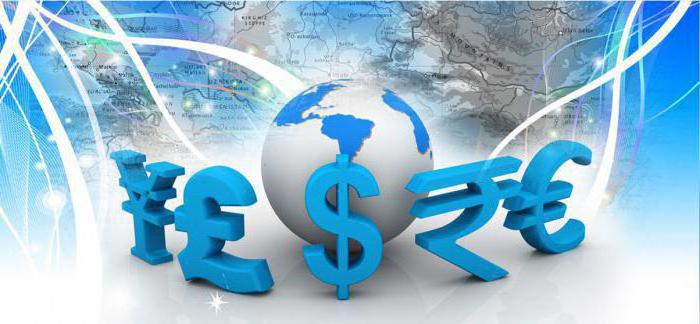Currency relations at the international level arose after money began to be used in international payment transactions. The forms of world money, as well as the conditions of international payments, have changed throughout history. At the same time, the importance of the monetary system between states grew, and the degree of its independence increased.
Every country has its own money. They act as a means of payment or exchange, a unit of account, serve as a means of storing value, and are used as a measure of deferred payments. This applies to both the domestic market and the external, in which they act as the national currency.
Without a sufficiently developed financial market, the economy of any country cannot exist. Of course, in world history there have also been non-monetary societies in which goods were exchanged directly. But we are talking about the present, about the current state of the economy. Foreign exchange markets are an integral part of financial markets. They can be both internal and regional. Stands out also world market. Let us dwell on it in more detail.
What is the global currency market?

This is the largest association. It includes all foreign exchange markets operating around the world. This market has been developing continuously, adapting to changing conditions, becoming more complicated, has gone from small centers of trade in bills of exchange to almost the only international market, whose role in the economy can hardly be overestimated. As the global foreign exchange market improved and developed, foreign exchange operations also developed. Their new species arose, and their technique improved.
Features of the international currency market
The international currency market (forex) includes individual markets that are localized in different regions of the planet, centers of monetary and financial transactions and international trade. A wide range of operations related to tourism, capital migration, foreign trade settlements, as well as various interventions and foreign exchange risk insurance is carried out on it. On the one hand, it is a special institutional mechanism that mediates the purchase and sale relations of various foreign currencies between brokers, banks, and other financial institutions (the place where the sale and purchase relations take place is the exchange). The foreign exchange market, on the other hand, serves the relationship between customers and banks (both individual and government, and corporate). Its participants, therefore, are central and commercial banks, brokerage organizations, government units, individuals, industrial and trading companies that operate with currency.
How is the international currency market organized?
This is the largest financial market in the world where foreign currencies are exchanged and international trade is carried out. Transactions for dozens, or even hundreds of billions of dollars, take place on it every day. The international currency market is not at all some centralized enterprise, as it might seem at first glance. It operates through a number of numerous institutions. Brokers and dealers who participate in the market process communicate with each other using various means of communication (telephone, Internet, etc.).

The largest centers of such events are New York, London, Tokyo and Frankfurt.
Commercial banks as an institution of the international currency market
Large commercial banks in the foreign exchange market are the main participants in the trading transactions taking place on it. In many cases, they play the role of dealers in the market process. In this capacity, commercial banks maintain the position of two or more currencies, that is, they have deposits denominated in these currencies.
For example, Chase Manhattan Bank has branches in New York and London. The first of them has deposits in pounds sterling in a branch operating in London, and the second - deposits in dollars in New York. The investor may provide each of them with foreign currency in exchange for a local deposit. The bank makes profit on such operations as a dealer, selling foreign currency at the “seller’s price”. This price is slightly higher than the "buyer's price", that is, the one at which this bank acquires this currency. The gap between the "seller’s price" and the "buyer's price" is kept by competition between banks, it is about 1% for large international operations.
Commercial banks sometimes act as brokers. In this case, they do not "support a position" in relation to certain currencies, but only bring buyers and sellers together. For example, a certain English company may ask one of the banks in London to act as a broker in organizing the exchange of dollars for the pounds it needs. In the international currency market, in addition to commercial banks, there are also a small number of non-bank brokers and dealers. Commercial banks use independent brokers as intermediaries when they enter into significant wholesale transactions with each other.
Exchange rate
Brokers and dealers who come to foreign exchange markets have continuous information (you can even call it momentary) about any changes in the exchange rates.

Other business agents whose need for this knowledge is not so operational can get relevant information from the Internet or daily newspapers in the financial chronicle section. For the previous two working days, most currencies are given. Usually they are presented in two ways:
1) as the number of units of foreign currency required to acquire one dollar and euro;
2) as the number of dollars and euros needed to purchase a particular unit of foreign currency.
Basically, for currencies, there is only one rate - the exchange rate for cash transactions. It is applied to most trading transactions - those that will be concluded in a period not exceeding two days. For many foreign currencies, in addition, rates for derivatives transactions are also provided. What is a derivatives transaction? This is a contract concluded between a bank and its client, in which dollars or euros will be exchanged in the future on a certain day for the desired currency at the exchange rate determined today. At the same time, the difference in the calculation of exchange rates for derivatives and cash transactions at any given moment reflects the difference existing in the compared countries between market rates of interest.
Factors that affect the exchange rate

There are many factors that more or less affect foreign exchange trading market, as well as exchange rates. We describe the most significant of them.
Trade balance
One of the main factors is trade balance. This is the difference between total exports and imports of a particular country. If in the structure of it foreign trade export predominates, this means that foreign currency flows in excess to the state, therefore, there is an increase in demand for the corresponding national currency, as well as an increase in its exchange rate. On the contrary, in a situation of a trade deficit (that is, when the export volume is less than the import volume), the national currency should weaken.In reality, the mutual influence of interest rates, inflation, exchange rates and trade mixes all these factors so much that the connection between them becomes completely unobvious.
Interest rates
This is another indicator with which you can track the dynamics, characterizing various foreign exchange markets. The interest differential is the difference in interest rates that apply to two specific currencies. This factor is the most important, which directly determines the relative attractiveness of these two currencies, and therefore the possible demand for one or another of them.

Many types of interest rates affect money market each state. This, for example, is the official interest rate - the one at which various banks borrow money from the central bank; interbank borrowing rates at which they borrow money from each other; rates that determine the profitability of government-owned securities, etc. All of them are closely related and are ultimately determined by the official interest rate (it is set by the Central Bank of the respective country).
The effect of interest rates on exchange rates
It is generally quite straightforward: the higher the interest rates, the higher the exchange rate of a particular currency. However, there are many circumstances that make it unclear and difficult to consider interest rates. First, it is necessary to take them into account, not by themselves, but real rates, that is, those that take inflation into account. The fact is that there is a strong connection between the foreign exchange market and the state-owned securities markets, which are very sensitive to inflation. If inflation in a given country begins to grow at a rapid pace, this will lead to the depreciation of government bonds, since they pay a predetermined, fixed income, and inflation can simply "eat" it.
In addition, the market today lives on expectations of important events and preparations for them, and not just reacts to facts that have already happened. If it seems that interest rates will be raised for a given currency, dealers will increase its rate, expecting a further increase, and operations in the foreign exchange market will be carried out at new rates.
Gross domestic product
This is a general indicator of the total amount of added values that were created for a specific period by all manufacturers operating on the territory of the state. GDP is a general indicator, an indicator of the strength of the economy or its weakness, observed during periods of recession. Its connection with the exchange rate is obvious and quite direct - the national currency is stronger, the stronger the GDP increases.
Inflation

Both the foreign and domestic foreign exchange markets are largely oriented towards inflation. It changes the price ratio, and hence the benefits actually received from the income that financial assets bring. Conducting an analysis of the foreign exchange market, it should be noted that rising inflation leads to a decrease in the real interest rate, because in this case, some part that will be used to cover the price increase should be subtracted from the income received.
Actions of central banks
The price of a currency, as you know, is determined by supply and demand on it in the international market. Therefore, for major currencies, exchange rates are created by the market. However, central banks have a number of instruments through which they can significantly influence them. They apply them based on the goals of their own financial policies, the main of which is to ensure the stability of the national currency. For example, today the hard currency is going through the Russian currency market. In this situation, the Central Bank is implementing a series of anti-crisis measures. For the sake of maintaining the ruble, exporters agreed to carry out currency injections into the market. And the Central Bank decided to raise the key rate.
Money supply
Excess of one currency or another leads to an increased supply of currency and will cause a depreciation of the currency in relation to others. Deficit, on the contrary, leads to an increase in the rate in the presence of demand for it.








